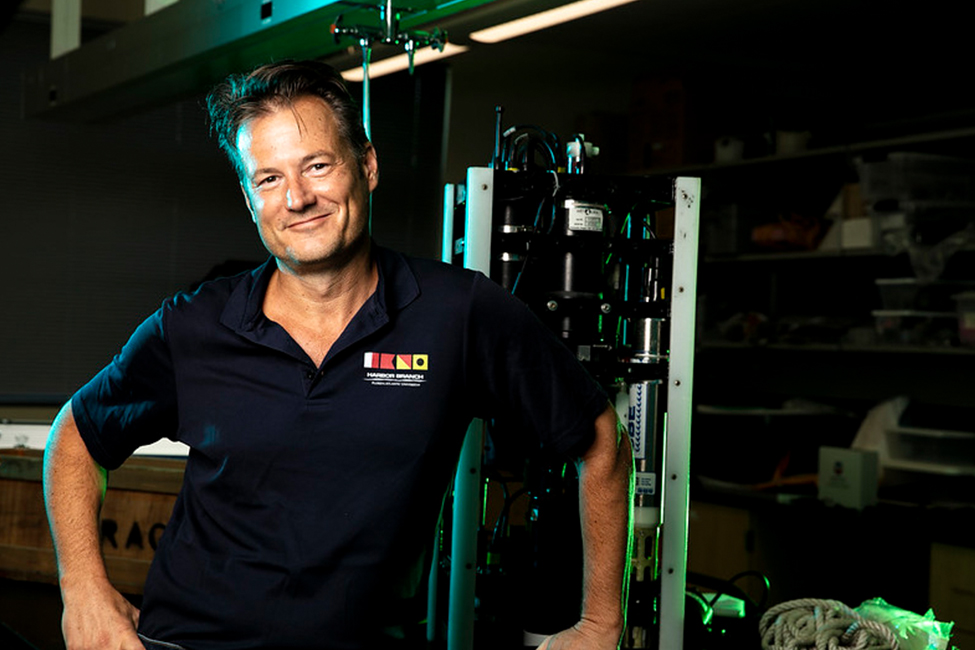EXPLORING THE OCEAN WITH TECHNOLOGY
by Bethany Augliere | Monday, Jan 04, 2021
Every night, the planet’s largest migration happens as animals travel from the depths of the ocean to feed at the surface. As the sun rises, they return back to the water column’s middle region, called the mesopelagic zone (ranging from about 500 feet to 3,000 feet) and it’s one of most understudied areas of the world’s oceans. Michael Twardowski, Ph.D, a research professor at Florida Atlantic University’s Harbor Branch Oceanographic Institute, hopes to use new technologies to shed light on this twilight zone and its many creatures. “Since the beginning of oceanography in the early nineteenth century, the big advances have been the result of new developments in technology,” he said.
Little is known about the twilight zone, despite the fact that it contains up to 90 percent of the world’s total fish biomass. “It’s a challenging environment due to the depth and many animals just swim away from any instruments you deploy,” said Twardowski. So, he’s working on new remote ways to study the organisms without being detected, such as using imaging with laser light.
Twardowski is a scientist in the field optical oceanography, which is the study of how light passes through the water. Specifically, he’s interested in developing new technologies to address problems in satellite ocean color remote sensing, harmful algal blooms, and oil detection, among others. To do this work, he’s often collaborating with engineers. “As a scientist you understand the technology needed and then you interact with engineers who will help you develop those technologies,” he said.
In 1998, Twardowski earned a Ph.D. in biological oceanography from the University of Rhode Island, one of the country’s top oceanography programs. Before coming to FAU’s Harbor Branch, he was the director of research at WET Labs, Inc. for 10 years, a company specialized in advancing oceanography instruments, particularly those related to optical sensors. In 2015, Twardowski came to FAU’s Harbor Branch as a research professor, and he also holds an affiliate professor position in Ocean Engineering at FAU.
One of Twardowski’s current projects is with NASA’s new PACE satellite mission to study the ocean ecosystem. The environmental research satellite is set to launch aboard the Falcon 9 rocket from Cape Canaveral in late 2022. Twardowski’s role is to help develop the physical models to interpret the ocean color imagery, which will contribute to global models for the carbon cycle. “Considering the oceans account for up to half of the planet’s uptake of carbon dioxide from our atmosphere, these images will be incredibly important in our understanding of climate change,” he said.
In his own backyard, Twardowski is part of the Florida Center for Coastal and Human Health funded by the Harbor Branch Oceanographic Institute Foundation (www.fau.edu/hboi/flcchh/) at FAU’s Harbor Branch to learn more about harmful algal blooms in the Indian River Lagoon, recognized as an “Estuary of National Significance” by the U.S. Congress. Part of the Center’s goal is to better understand the algal organisms producing the toxins, their distributions, and the environmental conditions that drive the toxins. To help do that, Twardowski’s role is to advance the algorithms for synoptically detecting coastal algae from ocean color images.
Twardowski is the Lead Scientist on a new $10M Navy project to study light emitted from ocean organisms, a process known as bioluminescence, and has other Navy projects related to improving our ability to understand ocean color and detection from the miniature satellites called CubeSats. This research is developing ways to better monitor and predict environmental conditions, such as visibility in the water, which directly relates to Navy operations. “Ultimately, if these models work better, we could be saving lives and supporting our national security. That’s one of the reasons I love my job.”
Read more in Portfolio Vero Beach.